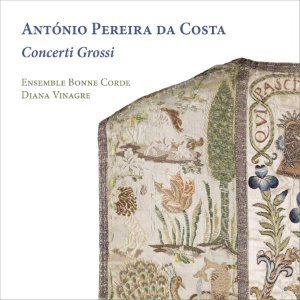
António Pereira da Costa (c1697-1770)
Concerto Grossi (1741)
Concerto VII in F major
Concerto VIII in C minor
Concerto IX in A major
Concerto VI in B minor
Concerto V in G minor
Concerto X in C major
Ensemble Bonne Corde/Diana Vinagre
rec. 2021, Igreja do Menino Deus, Lisbon, Portugal
Ramée RAM2104 [70]
These concertos are almost dead ringers for the celebrated set by Corelli (composed in the 1680s but not published until 1714, after his death) and are none the worse for that, although composed nearly sixty years after those and published in 1741 – making them later even than the other great and more advanced essays in the genre, Bach’s Brandenburg Concertos and Handel’s Opus 6. Although Portuguese music in the 18th century became almost wholly subsumed to the Italian style, even out in Madeira where Pereira da Costa was chapel master at Funchal Cathedral, the immediate cause for these compositions was as much to do with that country’s trading links with England, its political ally, where there was a particular vogue for such concertos. Indeed, the only surviving source for this collection of twelve is the set of parts held at the British Library, as they were published in London. Only the concertino and continuo cello part is missing, and so the organist and harpsichordist in this recording, Fernando Miguel Jalôto, has reconstructed that.
In his liner notes Jalôto enumerates certain characteristics of the Concertos’ musical style which depart from the strict Corellian model and could be termed Iberian or at any rate the personal idiom of the composer. But these are not imposed upon the music here by Ensemble Bonne Corde, and Corelli remains the overwhelming influence in their multi-movement structure which mix in at least one dance movement per Concerto. The ensemble’s one-to-a-part playing, led from the cello by Diana Vinagre, ensures crisp articulation of Pereira da Costa’s neat, regular phrases, and their pristine tonal production doesn’t require the performers to emphasise unduly the dissonances to bring out the exquisite beauty of the characteristic suspensions.
The dances have nicely pliant rhythms, for instance the Corrente of Concerto V whose whole bars of slurred quavers become vocal in quality; or, in what seems to be one of the music’s more pronounced Iberian qualities, the Minuets (notated in 3/8 time) are fairly brisk. But otherwise the tempos remain generally comfortable, and even in the soloists’ fast sequences of semiquavers in the principal Allegro movements, the overall pace is agile rather than furious. Textures are well balanced so that those virtuosic displays do not overly spotlight the concertino soloists, but keep in view the dialogue among all the performers rather than serve as the vehicle for one or two grandstanding soloists. If anything, such volleys of notes pass by like a powdery haze suspended in the generous acoustic of this recording, or with a slightly nervous, brittle character.
Occasional passages of denser polyphony are lucid and poised, avoiding ponderousness and maintaining what Jalôto humorously describes as the music’s character of ‘tropical Baroque’. The slow movements generally feature the organ in the accompaniment, adding an air of sustained solemnity, cushioning the string sonority that is warmly integrated, though moodier in the minor-key sections as in the Concerto VI in B minor. Such equanimity allows for a more striking climax by comparison, in the final Marcia of the Concerto X which ends this recording, featuring a boisterous battle style of music, like Biber’s famous Battalia. But overall it is the buoyancy and charm of these performances which stand out, instilling a fervent hope that this ensemble will follow up with a second volume and survey the other six Concertos of the set. The disc will be regularly in my CD player until then.
Curtis Rogers
Help us financially by purchasing from





















